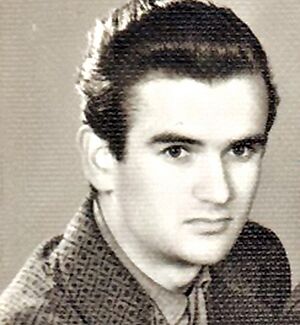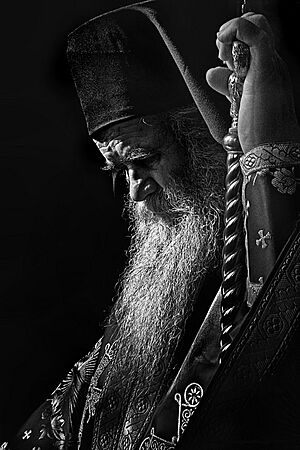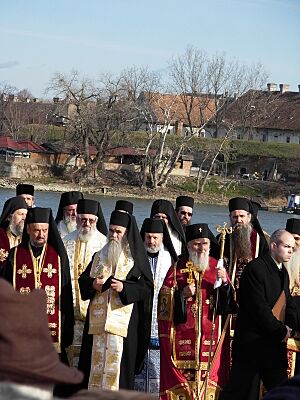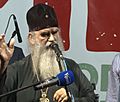Amfilohije, Metropolitan of Montenegro facts for kids
Quick facts for kids His Grace, Primate Amfilohije PhD, Th.D |
|
|---|---|
| Metropolitan of Montenegro and the Littoral | |

Metropolitan Amfilohije in 2016
|
|
| Native name | Амфилохије |
| Church | Serbian Orthodox Church |
| Diocese | Metropolitanate of Montenegro and the Littoral |
| Enthroned | 30 December 1990 |
| Reign ended | 30 October 2020 |
| Predecessor | Danilo III |
| Successor | Joanikije II |
| Orders | |
| Ordination | 1967 in Greek Orthodox Church |
| Consecration | 1985 by German, Serbian Patriarch |
| Rank | Metropolitan, Archbishop |
| Personal details | |
| Birth name | Risto Radović |
| Born | 7 January 1938 Bare Radovića, Zeta Banovina, Kingdom of Yugoslavia (now Montenegro) |
| Died | 30 October 2020 (aged 82) Podgorica, Montenegro |
| Buried | Cathedral of the Resurrection of Christ, Podgorica |
| Nationality | Montenegrin |
| Denomination | Eastern Orthodoxy |
| Previous post | Eparchy of Banat (1985–1990) |
| Alma mater | University of Belgrade Pontifical Oriental Institute University of Athens |
| Signature | |
Amfilohije (born Risto Radović, 7 January 1938 – 30 October 2020) was an important bishop of the Serbian Orthodox Church. He was also a theologian, a university professor, an author, and a translator.
He served as the bishop of Banat from 1985 to 1990. After that, he became the metropolitan bishop of Montenegro and the Littoral in 1990. He held this important position until his death. As the metropolitan bishop, he was the main leader of the Serbian Orthodox Church in Montenegro.
Amfilohije was one of the most influential leaders in the Serbian Church. He was known for his strong beliefs and dedication. His full religious title was: His Grace, Archbishop of Cetinje, Metropolitan of Montenegro and the Littoral, of Zeta, Brda (the Highlands) and the Skenderija, and the Exarch of the Holy Throne of Peć.
During his time as metropolitan, more than 569 churches and monasteries of the Serbian Orthodox Church in Montenegro were built or rebuilt. He was also a respected writer and theologian. He wrote over 1,000 works, and his selected writings fill 36 books. Amfilohije was seen as one of the most powerful people in Montenegro. He was also very influential within the Bishops' Council of the Serbian Orthodox Church, which is the highest body of the Serbian Orthodox Church.
Contents
His Life and Work
Early Life and Education
Amfilohije was born as Risto Radović in a place called Bare Radovića in Lower Morača, which was then part of Kingdom of Yugoslavia (now Montenegro). His family had a history of important leaders.
He studied at St. Sava's Seminary and then at the Faculty of Theology in Belgrade, graduating in 1962. He also studied classical philosophy in Belgrade.
Amfilohije continued his studies in different countries. He went to Paris, Rome, and Bern. He lived in Greece for seven years. There, he became a monk and took the name Amfilohije. In Athens, he earned his doctoral degree in theology. After spending a year at Mount Athos, he returned to Paris to teach. Later, in 1976, he became a professor of Orthodox catechesis (religious instruction) in Belgrade.
He received honorary doctorates from important theological academies in Moscow and Belarus. Amfilohije was very good with languages. He spoke Greek, Russian, Italian, German, and French. He could also use Old Greek, Latin, and Old Church Slavonic. He was a member of writers' associations in both Serbia and Montenegro.
Becoming a Bishop
In the 1980s, Amfilohije was named Bishop of Banat. He held this role until 1990. In December 1990, he was chosen to become the Metropolitan of the Metropolitanate of Montenegro and the Littoral. This was a very important position, and he held it until his death. His inauguration ceremony was attended by many important people.
Leading the Church in Montenegro
When Amfilohije became Metropolitan in 1990, the Serbian Orthodox Church in Montenegro was growing stronger after the end of communism. He started many projects to build new churches and monasteries and to restore old ones. His efforts led to more monks, nuns, and priests joining the church. Many Montenegrins were also baptized into Orthodoxy during this time.
Amfilohije also started a publishing house called Svetigora. It published church teachings, poetry, and news. In 1998, he also launched a radio station with the same name. He believed that religious education should be taught in schools.
He was a strong supporter of Serbian identity and the Serbian Orthodox Church. He believed that the Serbian people had a special role in the Orthodox East. He also thought that the Montenegrin nation was closely linked to Serbian heritage. He had disagreements with those who wanted an independent Montenegrin church.
His Role During Times of Change
Amfilohije was involved in the political and social discussions in Montenegro, Serbia, and Bosnia and Herzegovina. He often visited Serb soldiers during the Yugoslav Wars to offer his support. He also praised some of the Bosnian Serb leaders during the war.
His relationship with the Serbian President at the time changed. Amfilohije became a strong critic of the President's policies. In 1995, he spoke to the Montenegrin parliament, asking them to stop supporting the Serbian President.
In the late 1990s, Amfilohije oversaw 160 clergy members who served over 90% of the churches and monasteries in Montenegro. He was involved in discussions about Serbia joining the European Union, often expressing critical views.
In 2005, a small church was placed on top of Mount Rumija by helicopter. This action was seen as a symbol of the Serbian Orthodox Church's presence. Amfilohije supported this, stating that an old church had once stood there.
After Montenegro's Independence
During the 2006 Montenegrin independence referendum, Amfilohije supported Montenegro remaining united with Serbia. He was an important voice for Montenegrin Serbs. He opposed any future unification of all Orthodox churches in Montenegro.
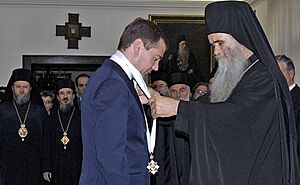
In 2008, when Kosovo declared independence, Amfilohije spoke about Kosovo as the "cradle of the Serbian nation." He also criticized some Serbian politicians for their approach to Kosovo. In 2007, he temporarily served as the head of the Serbian Orthodox Church when Patriarch Pavle was ill. He continued this role until a new patriarch was elected in 2010.
Amfilohije was known for his strong opinions on social issues. He was also critical of NATO, calling it a "militaristic, totalitarian, terrorist, international organization." He believed Montenegro should maintain close ties with Russia.
Recent Protests (2019–2020)
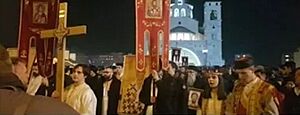
In late 2019, a new law about religious communities in Montenegro caused large protests. This law would have transferred ownership of church buildings from the Serbian Orthodox Church to the Montenegrin state. Metropolitan Amfilohije led many peaceful prayer walks and protests against this law.
These protests grew very large, with tens of thousands of people attending. They became some of the biggest public gatherings in Montenegro's history. In the parliamentary election in August 2020, Amfilohije supported the opposition parties. These parties won, and the ruling party, which had been in power for a long time, lost. The new government announced that they would withdraw the disputed law.
Death and Legacy
On 7 October 2020, Amfilohije tested positive for COVID-19. His health worsened, and he died on 30 October 2020, in Podgorica, Montenegro, at the age of 82.
Amfilohije was buried in the crypt of the Cathedral of the Resurrection of Christ in Podgorica, as he had wished. He donated his large personal library, with thousands of books, to the Stanjevići monastery.
His funeral was attended by thousands of people, including leaders from various Orthodox Churches, and representatives from Catholic and Islamic communities. Many political leaders from Montenegro and neighboring countries also attended. Speakers at the funeral praised his life and work.
The Prime Minister-designate of Montenegro asked the government to declare a day of mourning for Amfilohije, but this was refused. However, several cities in Montenegro declared a day of mourning locally. Sadly, Serbian Patriarch Irinej, who attended Amfilohije's funeral, later tested positive for COVID-19 and died 19 days later.
Public Opinion
Amfilohije was a complex figure. He understood the feelings of Montenegrin people and the social changes happening around him. He was respected by his clergy but also had critics. Public opinion about him was often divided, either very positive or very negative.
Among Montenegrin Serbs, Amfilohije was a very popular figure. Polls in 2003-2004 showed he was one of the most trusted public figures in Montenegro. Some Montenegrin groups and intellectuals saw him as a controversial figure who supported certain political ideas.
His supporters often called him "Đedo," which means "Grandfather." They also claim that more churches and monasteries were built or rebuilt during his leadership than during the time of the Nemanjić dynasty, an important historical period.
Awards
- Selected orders and medals
- Commemorative Medal of Bartholomew I of Constantinople, 1991
- Medal of the Greek Orthodox Church of Jerusalem commemorating 2000 years of Christianity, 2000
- Order of Lomonsov, The national committee of state awards of the Russian Federation, 2001
- Medal of the Greek Orthodox Church of Jerusalem commemorating 1500 years of Mar Saba, 2002
- Order of Saint Alexander Nevsky, I Degree, Russian Academy of Military Science, 2003
- Order of the St. Cyril of Turov, Belarusian Orthodox Church, 2008
- Order of Saint Prince Vladimir, Ukrainian Orthodox Church, 2012
- Order of The Holy Great Martyr George, Eparchy of Budimlja and Nikšić, 2013
- Order of King Peter of the Society for Nurturing the Traditions of the Liberation Wars of Serbia until 1918, 2014
- Medal of Orthodox Spiritual Academy of St. Petersburg of Saint John the Apostle, 2015
- Commemorative Medal of Vergina, Greece
- Moscow Theological Academy, 2006
- The Institute of Theology at the Belarusian State University in Minsk, 2008
- St. Sergius Orthodox Theological Institute in Paris, 2012
- Saint Petersburg Theological Academy, 2015
Selected Works
Amfilohije wrote a lot! His bibliography has over 1,000 items. His most important works have been published in 36 volumes. He also helped translate some books of the Old Testament into Serbian.
|
|
Images for kids
See also
 In Spanish: Amfilohije Radović para niños
In Spanish: Amfilohije Radović para niños


